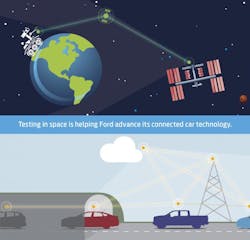Using space research to improve vehicle communication systems
[FYI: this is not the first time Ford’s gone into space to help it develop vehicle technologies back on Earth, especially in terms of safety.]
“The challenge of creating a robust wireless communications network is shared between the space and automotive industries,” noted Oleg Gusikhin (at right) Ford’s technical leader for advanced connected services, in a statement. “These first results are very promising in terms of offering more reliable communications technology for the future of connected vehicles.”
He added that the “primary goal” of this project is to develop “robust” communication technology to connect drivers and service providers with information and services via the “cloud.” The key problem with that, from Ford’s perspective, centered on maintaining reliable communication between vehicles and the cloud in “wireless overload” conditions in areas of poor network connectivity.
This this joint venture with a Russian university focused on data collection and transmission from moving vehicles via a variety of connection pathways – cellular, Wi-Fi, and communication with other vehicles and surrounding infrastructure.
Ford then said its team created an “intelligent connectivity manager” based on software and algorithms to select from available connections the option best suited to transmit data to the cloud, with each vehicle given the opportunity to assess the quality of communication channels and then transmit data.
With that in mind, here’s a scenario Ford believes illustrates how this “connectivity manager” would work: Picture a car entering a tunnel, encountering black ice, and thus needing to signal other motorists regarding the slippery conditions.However, there’s no cellular reception, and Wi-Fi is not an option because there’s no hot spot, but another car leaving the tunnel in the opposite direction has both vehicle-to-vehicle and a cellular connection.
The “connectivity manager” detects this and thus selects the other car’s vehicle-to-vehicle channel to deliver information gathered from the first car to the cloud so that it can then transmit a warning to other drivers of the dangerous conditions at the tunnel entrance.
Yet if no other vehicles are around, the connectivity manager would then postpone sending the message until the first car leaves the tunnel and a cellular network becomes available.
Now, in “non-emergency” situations, Ford said the connectivity manager is programmed to continually check the “coverage map” to determine the best point for service delivery. So if a vehicle is traveling in a remote area and a software update is sent out, the update would be delivered over the air when the connection is strongest, the OEM noted.
This, however, is only the beginning. Down the road, as information is collected simultaneously from hundreds of vehicles, a universal “connectivity map” can be created to reflect current data at all times; thus acting as a real-time database for implementing smart roads and smart city projects.
This means, according to Ford, that in any given situation, whether moving or parked, the vehicle with the most stable connection – cellular, embedded modem, Wi-Fi, vehicle-to-everything – can function as a “central communication hub” providing reliable connections for the entire motoring community.
Ford expects to wrap this project up by the end of this year and hopes to begin integrating some of those capabilities into its production-level vehicles soon – including vehicle-to-vehicle communication, the delivery of emergency messages and over-the-air software updates.
We’ll see how that goes.


